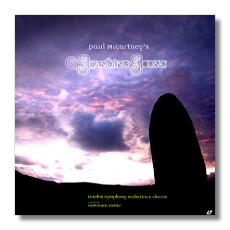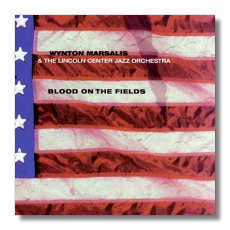
The Internet's Premier Classical Music Source
Related Links
- Latest Reviews
- More Reviews
-
By Composer
-
Collections
DVD & Blu-ray
Books
Concert Reviews
Articles/Interviews
Software
Audio
Search Amazon
Recommended Links
Site News
 CD Review
CD Review
Crossing Over

Paul McCartney
Standing Stone
London Symphony Orchestra & Chorus/Lawrence Foster
EMI 56484 76:45


Wynton Marsalis
Blood on the Fields
Wynton Marsalis, trumpet
Wilson, Hendricks, Griffith (vocals)
Lincoln Center Jazz Orchestra/Wynton Marsalis
Sony/Columbia CXK57694 3CDs 58:41 + 52:50 + 50:49
Summary for the Busy Executive: The siren song.
George Gershwin may not have been the first or even the best composer to attempt a synthesis of pop and classical, but he certainly had the most impact. He became an iconic figure to certain composers who either tried to follow him or to show him where he had gone hopelessly wrong. A very well-respected jazzman once remarked to me of such syntheses, "If I can't imagine Louis Armstrong playing it, it's not jazz." In the same vein and with the same sense of restriction, I would say, "If I don't feel in the presence of an extended argument from a small set of basic materials, it's probably not classical."
However, I don't really see why such a synthesis should strike anyone as the squaring of a circle. After all, the history of music is full of crossovers. Classical composers have taken from popular sources, and one can point to several examples of popular musicians fruitfully influenced by classical music. Composers can use jazz and pop in several ways:
- As a kind of exotic color laid over essentially a classical foundation. Gershwin is the most conspicuously successful of these composers, although others would include Ravel, Devreese, Debussy, Stravinsky, Milhaud, Martinů, Antheil, and the explicit "jazz" pieces of Copland.
- Without significantly thinking about it. After all, composers are people too. American composers in particular have heard as much junk as American non-composers. The "hard" music of Aaron Copland uses rhythms that probably wouldn't have occurred to someone who hadn't heard jazz. In short, one finishes a phrase in a certain way or dances a certain way because the "inner music" has been shaped by a certain experience.
- By thinking about it. Here, we have the "third stream" of Jimmy Giuffre, Gerry Mulligan, Mingus, Russell, Roach, Taylor, and Schuller.
Wynton Marsalis has crossed over throughout his career. Thoroughly trained in both classical and jazz, he has performed successfully in both. His classical trumpet career has waned of late, but (as his father, Ellis, remarked) there really are only so many pieces in the classical trumpeter's repertory. Wynton has always interested himself in arranging, coming up with incisive charts that also make the players sound good. However, more and more he has come up with longer pieces – putting jazz musicians in classical-concert situations. I remember in particular a ballet, Citi Movement. Certainly, Blood on the Fields, a jazz oratorio on the subject of slavery, counts as his most ambitious project to date.
The work has enjoyed spectacular worldly success: a Lincoln Center première, an album release, and the Pulitzer Prize. For me, it's a piece so awful, only a genius could have written it. It suffers most from what seems the brain-deadest libretto ever written by anybody. For example:
Look and see
To learn and be
One part of we
And not just ye
If you'd be free
That's by no means the worst one meets in this misery of a text. To call the characters – a wise, magical "fool," a female doormat, and an Angry Young Man – "cardboard," gives the author way too much credit. They mouth slogans, purple patches, and psychobabble. It angers me, because I consider the theme of American slavery and its consequences one of the most important an American artist can take on, but it imposes a responsibility for maturity and enlightenment. Suffice to say, on these two scores, the libretto operates at a far lower level than, say, Robert Hayden's "Frederick Douglass." Marsalis didn't write this mess, but he chose it. Still, composers have occasionally triumphed over bad libretti, just not here. Musically, the work rambles and natters. The text provides little obvious opportunity to soar. The musical dithering contradicts Marsalis's normal profile as a player and composer, marked by an almost ruthless economy of notes and drive of idea. I can surmise only that the text flummoxed him, as it would have almost anybody.
Of the performers, Jon Hendricks, as the trickster-shaman, comes over best, with a great show-biz bounce. He also has the best music. I've never been a fan of Cassandra Wilson, and I don't know Miles Griffith's other work. However, judging them by this performance would be unfair. The Lincoln Center Jazz Orchestra, led by Marsalis, consists of wonderful musicians, but the playing is unfocussed. They fail to catch the impulse of the music, which at slightly under three hours seriously handicaps them. The recording seems taken from the live performances. I doubt a studio recording would have improved the result, however.
In short, the piece disappointed me, but I look to Marsalis to find his feet again. His Citi Movement I believe one of the most successful extended jazz works of recent years, and if anyone has the composing chops and interests to add to the classic-jazz repertory, it's Wynton Marsalis.
McCartney long ago passed into the category of classic with his songwriting for the Beatles. However, he has for a long time itched to compose extended classical works. He has never formally studied, and he has problems reading music. He can't even write it down through conventional notation. Because of all this, even the announcement of these works has elicited a sort of "how dare he" response from some music lovers. When the notice came out about Standing Stone, I hadn't seen eyebrows arched so far back since Margaret Dumont in Night at the Opera, even though clearly most of the criticism came from people who hadn't heard the work (always a dubious proposition).
One might ask the question whether, given today's MIDI technology, one needs to read music in order to compose long works. McCartney certainly has access to the best hardware and software and to the people who can teach him how to use it. His distinction as a melodist and harmonist I don't doubt.
McCartney's obvious musical talent and his equally-obvious means to realize a project (money, connections, time) allied to the desire to stretch himself have always struck me as admirable, whatever I thought of the results. After all, he could have spent the bucks on a fleet of solid gold dune buggies. Furthermore, he seems to learn something essential with each project of this sort. For example, from Liverpool Oratorio (the only section I thought successful was the Jamaican song) he became aware of some of the considerations of structuring a long piece, that pure inspiration – which carried him through writing a pop song – probably wouldn't get him through an extended piece. He needed architecture. Where, for instance, would he place a climax?
McCartney still hasn't worked with the usual forms of classical music, but that's not as important, it seems to me, as knowing that the piece needs some sort of structure and building it. The structure of Standing Stone comes from a poem written by McCartney. A throwback to Sixties flower power, as literature, it won't win the Bollingen Prize. As a "libretto for the mind," it serves the composer well enough. As with Richard Strauss, much of the structure comes from the poem's narrative as well as its images. Fortunately, listeners don't need the poem to enjoy the work, and, unfortunately, the poem doesn't really clarify the music to the listener, however it may have helped the composer.
Some listeners find the idiom derivative, and you definitely hear bits of Ravel, Delius, Holst, and lush Hollywood movie scores. But I believe in giving the composers their language. The better question seems to me whether composers say something interesting in the idiom they choose. The work, which clocks in at more than an hour and a quarter, doesn't move altogether convincingly. There are long stretches of aimlessness – textures that go on too long, short ideas repeated rather than developed. The narrative structure isn't enough. McCartney needs to learn the little tricks of unity employed by composers since at least the Renaissance. However, to do so probably requires him to learn to read music – to manipulate music as pattern, not just as sound or melody. Episodic as it is, my favorite movement remains the second, due to the quality of the basic musical ideas and to its relative coherence as a movement. Some of the ideas throughout Standing Stone are first-rate, in fact, but because McCartney's repertoire of manipulation is so small, he has to use far too many of them to fill out the time. There's more than enough material for six large works. I may adore the love theme that ends Standing Stone (the choral lyrics are another matter), but it has little to do with the rest of the finale.
A problem of attribution continually vexes me. McCartney's contribution consisted of playing the work into a computer, which came up with a rough score. As anyone who has used MIDI software knows, the computer tends to take a human at his word, especially regarding rhythm, and few humans play in tempo strict enough for a computer. As a result, notated bar lines may not match up to the bar lines one hears. There will usually be fine adjustments of things like triplets and other rhythms. McCartney's computer "score" was passed off to a musician who cleaned it up and handed it off to composer Richard Rodney Bennett and a team of orchestrators who produced the final version. Much of what I like about Standing Stone is its orchestration and counterpoint. Richard Rodney Bennett and John Harle, among others, orchestrated it. Bennett and Harle have always been marvelous orchestrators – no news there. The counterpoint is tremendously clear and independent, but I have no idea whether that's due to McCartney or to his refiners. Some of the textures I have no trouble attributing to McCartney – basic tune with accompaniment and, in one passage, an "Ivesian" soup, which I nevertheless admire as a sign of McCartney trying to break free of the contrapuntal restraints imposed by his keyboard technique. On the other hand, especially in passages of folk-like dances during the last movement, the counterpoint becomes downright sophisticated. Is this McCartney or his elves? A combination? I have no idea.
The sound is gorgeous and the playing better than it had to be. If you're looking for another Sibelius symphony or Rachmaninoff concerto, this might disappoint you. It fascinates me mainly as a document in McCartney's progress as a composer of large works. I think it an advance over the Liverpool Oratorio, and it kept my interest enough to want to hear what McCartney will do next.
Copyright © 2001, Steve Schwartz




















